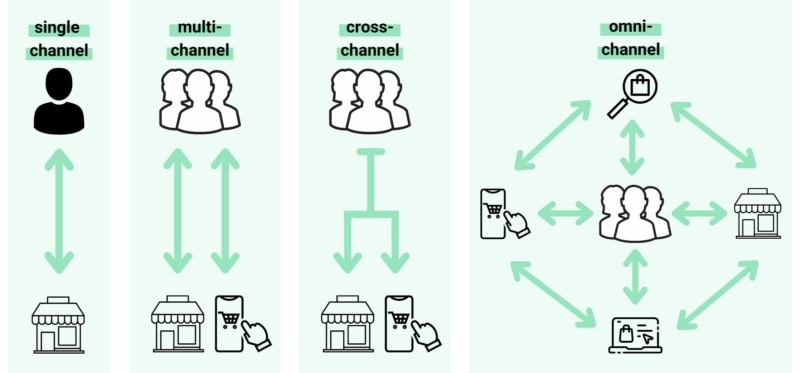3 tips for your start in multichannel
In 2021, according to statistics, about 95 % of internet users also made purchases online. Ecommerce is booming across different platforms for a long time and is no longer considered a trend. If you want to expand your channels to boost your sales, consider these three tips when starting as a multichannel merchant.
Channel types in ecommerce
In general, there are four different types of distribution that you probably already know:
Single channel-,
multichannel,
cross-channel,
and omnichannel distribution.

In single channel distribution namely only one channel is used by you as a merchant. For example, you operate your own online shop, but are not active on marketplaces. The other three sales models are cross-platform sales types in which you expand your sales activities to different sales channels.
In cross-channel and omnichannel sales, the sales channels support each other. This means that customers interact with you at different stages in their customer journey. The “click-and-collect” principle has become increasingly important, especially during the Corona pandemic and is a classic practical example of cross-channel sales. Omnichannel distribution is a combination of multichannel and cross-channel distribution and thus also the most comprehensive type of distribution, in which your customers use several channels in parallel while shopping. For instance, customers see a product in-store that is not available in their size. A QR code on the product directly leads them into the online shop where they have access to all sizes and can directly order it online for delivery or pickup.
In multichannel sales, on the other hand, the sales channels are not connected, as they are all operated independently of each other and side by side. It is irrelevant whether the sales channel is your own online shop, a marketplace presence or a local store. One advantage is that your customers can choose the sales channel that suits them. This increases your reach and the chance that your target group will choose to buy from you – regardless of which sales channel or shop opening hours. This leads to an increase in sales, as customer satisfaction increases due to the choice of sales channels. Additionally, multichannel distribution provides stability for your business, which was particularly evident during the pandemic. When shop doors were closed, customers suddenly couldn’t longer buy in stationary shops. Merchants who were able to adapt to online sales channels became winners of the pandemic.
Build your multichannel strategy with these tips
Once you have decided to get into multichannel sales and expand your sales activities to one or more additional platforms, you should prepare your strategy. One concern that many merchants have about multichannel sales is that selling on multiple platforms requires more effort than selling on just one platform. To ensure that multichannel sales do not become a time-consuming and unmanageable task, there are a few tips that you should consider.
#1 Prepare all areas of the company for multichannel
If you are planning to expand your sales activities to additional channels, the first tasks that come to mind are directly related to sales on the platforms, such as:
- Create merchant profile
- Posting items including item texts and images on the platform
- Checking that there are sufficient stocks in the warehouse
Apart from these tasks, there are many other aspects to running a successful multichannel business. This includes, for example, customer service. On marketplaces, your customers often have the possibility to write you a message directly there. The big advantage for customers is that they do not have to leave the platform. Merchants, on the other hand, always have to keep an eye on different channels in order to respond to all customer messages within a reasonable period of time. The shipping process of your orders can also be designed differently on different platforms. For instance, you may have to meet certain time frames for shipping the order to avoid being penalised by marketplaces.
Accordingly, your entire team should be involved in the process and the eventual restructuring of these processes so that everyone knows at all times what the requirements of specific channels are and how to meet them.
#2 Automation as a step to success
Automation is an often underestimated tool in ecommerce. We often hear merchants say: “My shop is still much too small for automation”. Actually, your shop can never be too small for automation – 0nce the automations are set up, order processing becomes easier than ever!
With automations, you can not only increase customer satisfaction because your customers get all the information they need about their order process at the right time and completely automatically, but you can also manage stock across platforms or create and send order documents automatically, thus saving you a lot of time. You can then in turn use this time to further develop your multichannel strategy or to handle other operational and strategic tasks.

#3 Always keep an overview
Keeping an overview is a no-brainer at first glance, but it is actually one of the most important success factors. With a strategic approach and good planning, multichannel sales can lead you to success.
First and foremost, you should keep an overview of your stock levels on the different platforms, as well as of the entire order processing. Ideally, you will be supported by a tool that will even take over a large part of the tasks. If all orders are collected in one tool, regardless of which platform they were placed on, you have a centralised point of contact for order processing. This saves you the unnecessary extra effort of having to gather different information from different sources, and information (such as stock levels) can always be kept up to date across platforms.
This is exactly what tools like Billbee are for. Billbee serves as the centre of your order processing by bundling product management, order processing and automation in just one tool. Through the connection of your ePages shop as well as all relevant marketplaces (e.g. Amazon, eBay or Etsy), Billbee is particularly suitable for multi-channel merchants. In addition to a simple and self-controlled setup, Billbee can also serve with the connection to various other tools, including shipping service providers or accounting software. Get more information and test Billbee now! You can find the app in the administration area of ePages Now under Apps. Please note, that the availability can depend on your reseller and selected shop package.
Jana Klingelhöfer (Billbee)
Jana is content manager at Billbee. When she's not shooting a new How To video for Billbee's YouTube channel, she takes care of the blog and website.
This post is also available in: German
